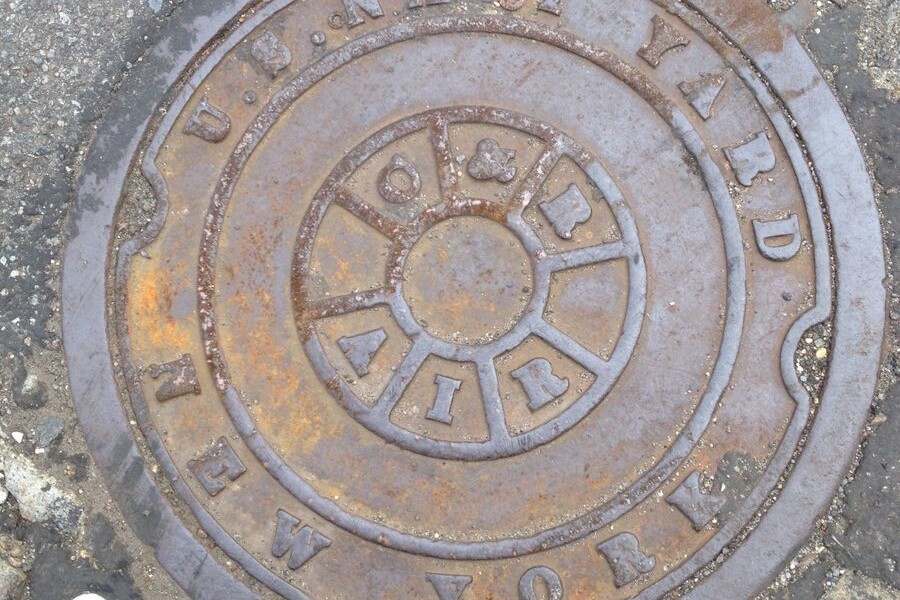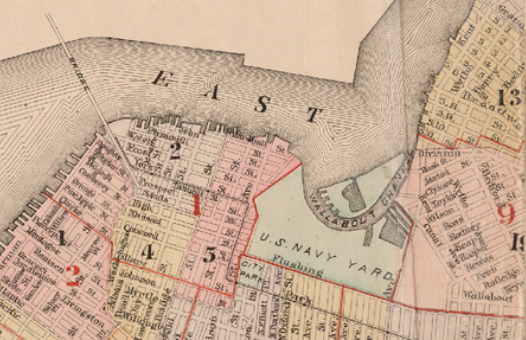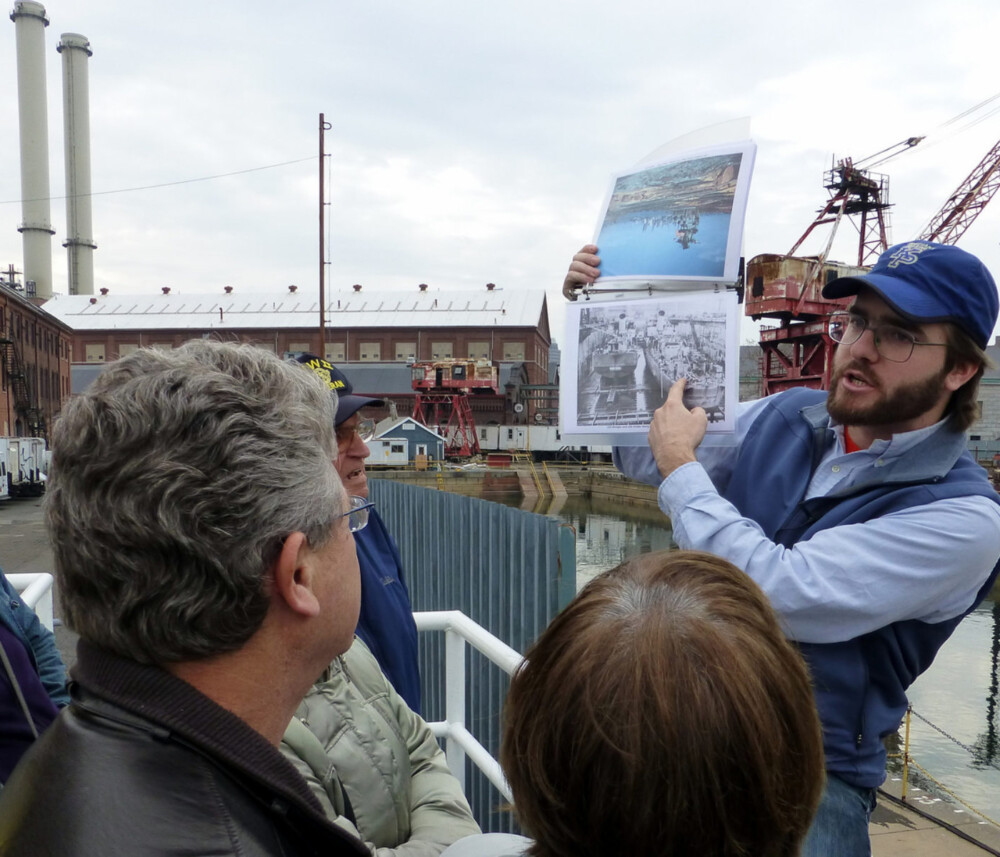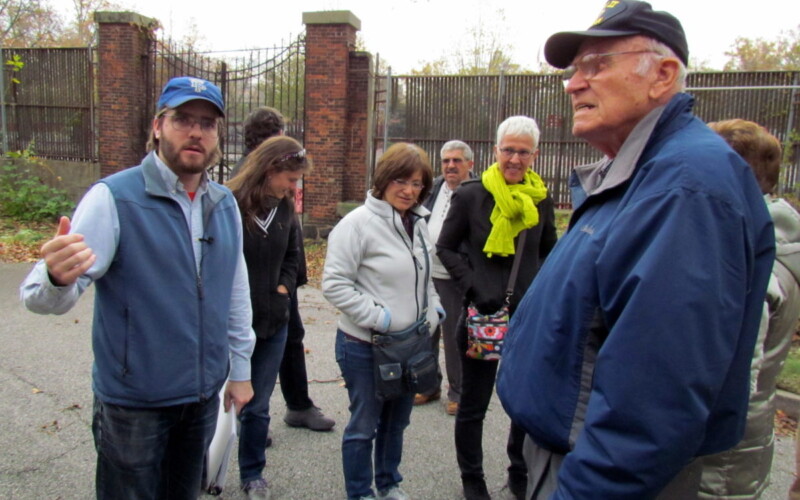Some of the subjects we frequently have to address on our tours of the Brooklyn Navy Yard are: where is it? and what is the official name?
So let’s start with the first question. The Brooklyn Navy Yard is located on the banks of the Wallabout Bay, a bend in the East River located opposite Manhattan’s Corlears Hook. The Yard has grown considerably since it was established in 1801 with the purchase of 23 acres of land on the bay’s western shore. Today, it encompasses 300 acres that encircle the bay from west to east, bounded by Little Street and Navy Street to the west, Flushing Avenue to the south, and Williamsburg Street, Kent Avenue, and Division Avenue to the east.
The Brooklyn Navy Yard has had a fence around it since 1823, and today public access to the city-owned industrial park is restricted. Though the level of security has varied over its history, the main point is that there has always been a clear separation between the Yard and the surrounding neighborhoods. While the area around Sands Street that is now the Farragut Houses has historically been known as the “Navy Yard District,” it has become a common (and unwelcome) practice in real estate to refer to places in Fort Greene, Vinegar Hill, and Clinton Hill as being “in the Brooklyn Navy Yard.” Unless the property falls within the boundaries of these 300 acres, it’s not part of the Navy Yard.
Similarly, there is confusion about the place’s name, and this is not helped by longstanding conflict between local practices and the naval bureaucracy. Technically, the name of the place from its founding in 1801 until 1945 was either “United States Navy Yard, New York” or “New York Navy Yard.” But, from the incorporation of the Village of Brooklyn in 1817 until the present day, the place was known as the “Brooklyn Navy Yard” essentially everywhere outside of the federal government.
The first big name change came on November 30, 1945, when Secretary of the Navy James Forrestall decided to consolidate all the naval facilities in the region into something called “United States Naval Base, New York”; the headquarters of this new entity would be at the “United States Naval Shipyard, New York.” This decision sparked a firestorm of controversy, with the Brooklyn Daily Eagle declaring that “the name change leaves us cold,” and that “the Brooklyn Navy Yard will be called just that in spite of the navy big brass.” Local officials, including Brooklyn’s Congressional delegation, were so incensed that they threatened legislative action to force the Navy to adopt “Brooklyn Navy Yard” as the official moniker.
The Navy did reverse itself, but not in the way that officials had hoped. A few days later, Forrestall issued a new directive that the Yard would be known instead as the “New York Naval Shipyard, Brooklyn, New York.” The New York Times derided the new title as “ponderous,” and even asked a taxi driver how he would get there. “Look, bud,” he replied. “I’ll take ya’ to the Brooklyn Navy Yard. They’ll tell ya’ how to get to this new place.”
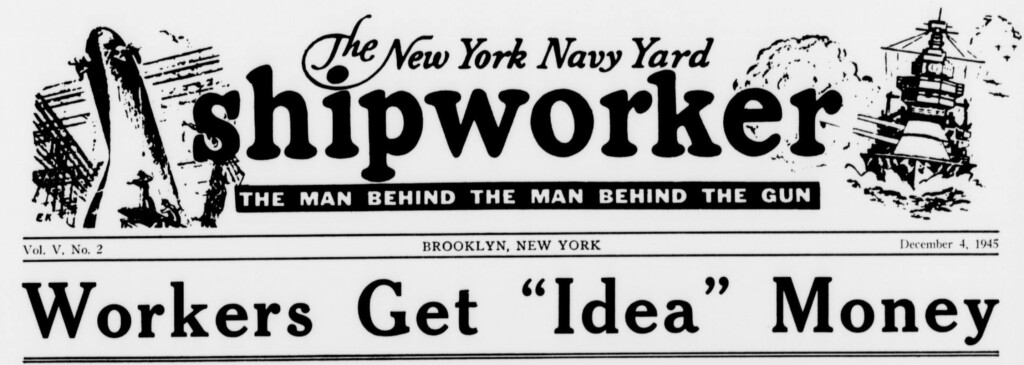
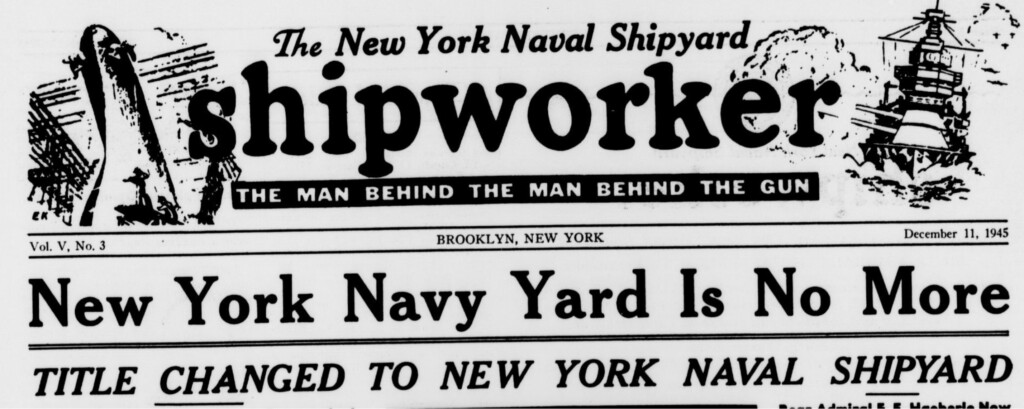
Of course, the name change required new signage throughout the Yard, a new title flag for the shipyard newspaper, and even a new name for the Yard’s band (they ultimately decided to scrap the “ponderous” title altogether and call the band the “Shipbuilders”). Despite the weeks of back-and-forth, the name “New York Naval Shipyard” would stick for 21 years, until the Yard’s decommissioning in 1966. It was only after the city acquired the site that it officially got the name it had so long been known as, and today it is managed by the non-profit Brooklyn Navy Yard Development Corporation (BNYDC) – not the “United State Naval Shipyard New York Development Corporation” or the “New York Naval Shipyard Development Corporation.” Brooklyn.
But that’s not the end of the story. Though most of the Yard was sold to the City of New York in 1969 and redeveloped as an industrial park for private businesses, the Navy maintained a presence on the site for another two decades, and this led to new appellations for these fragments of the once-mighty naval base. It became part of “Naval Station New York,” which included the former Naval Hospital campus on the southeast corner, the Admiral’s Row property on the southwest corner, and a handful of other buildings, including Building 92, the Naval Receiving Station on the south side of Flushing Avenue, and the Material Sciences Laboratory. This naval station closed in 1993, and the city has since acquired almost all of these properties (the Receiving Station is now the mixed-income Navy Green development, and the Yard’s Building 4 is the last one in federal hands), bringing them under the “Brooklyn Navy Yard” name. “Brooklyn Navy Yard” is even a registered trademark owned by the BNYDC.
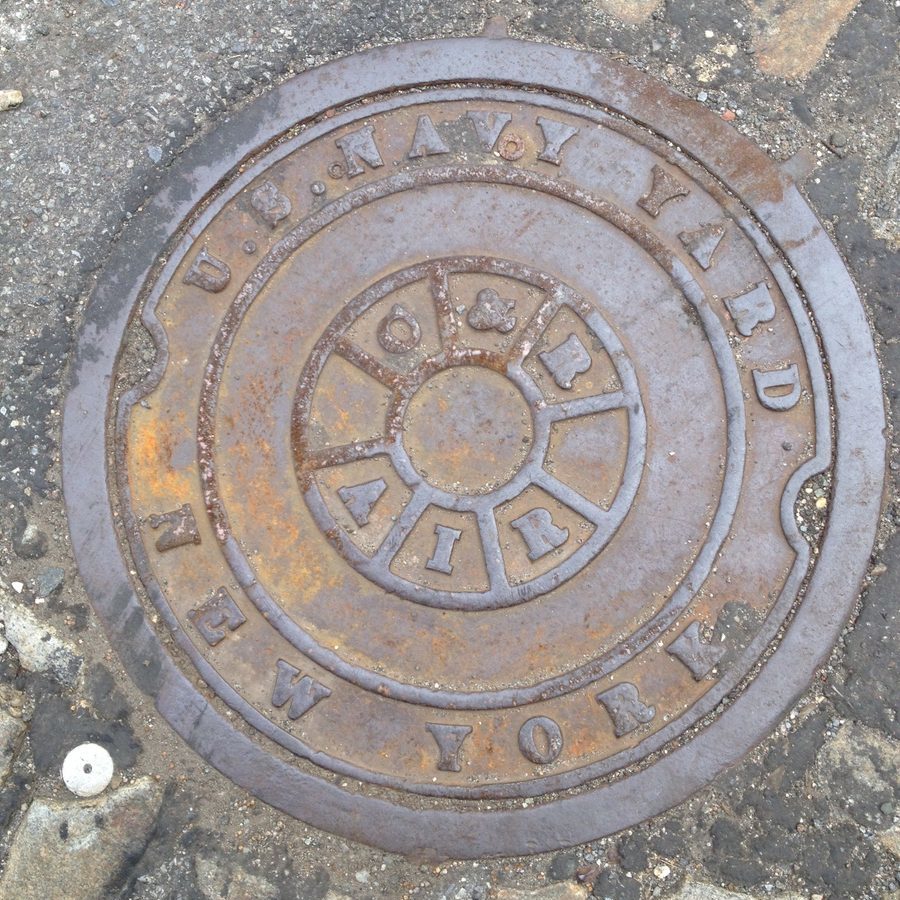
One important takeaway from this history is that at no point, officially or colloquially, has the place been known as the “Brooklyn Navy Yards,” plural. Just like every other naval shipyard, active and retired, it was always just one shipyard, not multiple; it is not several shipyards or rail yards encompassing many different entities and operations. The plural is incorrect, as are “Brooklyn Naval Yard” and “Naval Yards.”
Lastly, we should add that the Brooklyn Navy Yard is not the only shipyard with a confounding history. It is often confused with the New York Shipbuilding Corporation, which was not even located in or near New York State. The private company was founded in 1899 with the intention of establishing a shipyard in Staten Island; plans changed, and the company finally set up shop on the banks of the Delaware River in Camden, New Jersey. The Brooklyn Navy Yard is also separate from the Federal Shipbuilding and Drydock Company of nearby Kearney, New Jersey, which was not, despite its name, a federally-owned shipyard (though, like the BNY, it is currently being redeveloped as a multi-tenant industry and innovation center). During World War II, there were dozens of shipbuilding and repair yards in New York Harbor; the Brooklyn Navy Yard was just one.
With the exception of the Philadelphia Navy Yard, all of the “original six” shipyards have also suffered from name confusion. The Boston Navy Yard is located in the city’s Charlestown section, and it was originally known as the “Charlestown Navy Yard”; this has led to confusion with the Charleston Navy Yard, established in 1901 in North Charleston, South Carolina. America’s largest naval facility is the Norfolk Naval Shipyard, which isn’t even located in Norfolk; it’s across the Elizabeth River in Portsmouth, Virginia. This is understandable, as it gets its name from the (now abolished – yup, nothing can be simple in this story) Norfolk County, but it creates additional confusion for the Portsmouth Naval Shipyard, which is named for the wrong city in the wrong state. When a small island in the Piscataqua River was purchased in 1800 for a shipyard, it was believed to be in Portsmouth, New Hampshire. After years of litigation, a 2002 Supreme Court decision established that the area now known as Seavey’s Island, and still home to an active naval shipyard, is, in fact, in neighboring Kittery, Maine.

